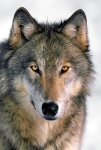
Update: June 30, 2012
I posted this in 2009, just as the first wolf hunts were underway in Montana and Idaho. I believed that if we provided fish and game managers with scientific fact about the detrimental effects of wolf hunting it might have some effect. How naive I was! The only thing they care about is pleasing two groups of people (hunters and ranchers) and “managing” wolves down to a shadow population of 100 to 150 animals per state.
===
November 5, 2009
It turns out wolves age just like people and according to wolf researcher, Daniel MacNulty, by age four, wolves are considered old. This insight into the life span of wolves could have far-reaching implications concerning “managing” them. The older the wolf, the less threat they are to elk, due to their reduced physical stamina.
The teenagers and young adults of the pack do most of the leg work chasing down prey, while the older wolves are important at the end of the chase, with their larger bodies and heftier builds, they help youngsters with the take down. It all makes perfect sense. Dr. MacNulty states hunting wolves to reduce their numbers may backfire.
“It’s been shown in other hunted populations of wolves that hunting skews the population toward younger age classes,” he explains. And, as his research shows, that could spell more deaths, not fewer, for the elk.
The reason hunting pushes a population’s age structure downward is because being hunted is like playing Russian roulette. If, starting early in life, every member of a society had to play Russian roulette regularly, not too many would live to a ripe old age, he says.”
But wolf supporters don’t really believe wolf hunts are about “the science.” Still I’m hopeful Dr.MacNulty’s research will open a few eyes.
===
Washed-up wolves
Surprising discoveries about aging wolves and their effects on elk

The elk-hunting skills of wolves decline significantly with age, a University of Minnesota study shows.
Photo: Douglas Dance
By Deane Morrison
Contrary to their fearsome, folk tale-rooted image, wolves just aren’t all that good as predators. To bring down big prey, they have nothing but speed and teeth–no claws that can rip flesh, no massive paws to kayo their quarry.
Now, a University of Minnesota-led study of wolves in Yellowstone National Park shows how even that modest ability soon ebbs away. Daniel MacNulty and his colleagues found that the wolves were in their hunting prime at the ages of 2 and 3, but then their skills deteriorated steadily. They lived, on average, till age 6.
Writing in the September 23, 2009 issue of Ecology Letters, MacNulty, a postdoctoral researcher in the University’s Department of Ecology, Evolution and Behavior, and his colleagues reported that the higher the proportion of wolves older than 3 in the park, the lower the rate at which they kill elk, their main source of food. The findings run counter to a belief, held by many ecologists, that wild predators maintain their physical skills as long as they live.
But the study “shows that aging impairs the ability of the wolves to catch elk,” says MacNulty, “The data connect aging with an important ecological process, namely predation.”
MacNulty has followed the Yellowstone wolves since their reintroduction to the park in 1995. He says the lowered hunting ability of older wolves may afford some protection to the elk, which would fare worse if all the wolves were spring chickens.
“For example, when 22 percent of the wolves in Yellowstone were 3 or older, the kill rate was 0.4 elk per pack per day,” says MacNulty. “If the older wolves were 52 percent of the population, the kill rate dropped to 0.22 elk per pack per day.”
In general, for every 10 percent rise in the proportion of wolves older than 3, the Yellowstone wolf population saw a decline in the kill rate of 10 to 15 percent, he says.
“… [W]hen 22 percent of the wolves in Yellowstone were 3 or older, the kill rate was 0.4 elk per pack per day. If the older wolves were 52 percent of the population, the kill rate dropped to 0.22 elk per pack per day.”
MacNulty has also documented the decline of individual aging wolves’ hunting skills. For example:
“Wolf number 21 in the Druid Peak pack lived to about 9,” he says. “Video of 21 over his lifetime showed him slowing down when chasing elk as he neared the end of life.”
As the geezer wolves lose their edge, the study suggests that young adults in the pack shoulder more of the workload and share their kills. This may provide aging members of the pack with a lupine version of social security.
Why wolf hunting may backfire
The number of elk in Yellowstone has declined in recent years, and many believe wolves are the main cause, MacNulty says. But he notes that drought, which has reduced the supply of plants elk eat, and predation of elk calves by grizzly bears have also probably contributed.
Montana legalized wolf hunting after the animal was taken off the endangered species list in 2008. But hunting of wolves won’t necessarily help the elk, and not just because only a few wolves have been taken so far, MacNulty says.
“It’s been shown in other hunted populations of wolves that hunting skews the population toward younger age classes,” he explains. And, as his research shows, that could spell more deaths, not fewer, for the elk.
The reason hunting pushes a population’s age structure downward is because being hunted is like playing Russian roulette. If, starting early in life, every member of a society had to play Russian roulette regularly, not too many would live to a ripe old age, he says.
Currently, MacNulty is working with a colleague at Michigan Technological University to “nail down,” or quantify, the effect on elk of wolf management that involves hunting.
“We’re modeling wolf-elk dynamics and looking at how changes in wolf age structure affect elk numbers,” he says.
http://www1.umn.edu/news/features/2009/UR_CONTENT_143264.html
===
Photo: Courtesy Douglas Dance
Categories posted in: gray wolf, wolf recovery, wolves under fire
Tags: gray wolf, wolf recovery, wolf research, senior wolves, MacNulty

























 Boulder White Clouds Council
Boulder White Clouds Council Exposing The Big Game
Exposing The Big Game Footloose Montana
Footloose Montana Friends of the Clearwater
Friends of the Clearwater Lockwood Animal Rescue Center
Lockwood Animal Rescue Center Louise du Toit
Louise du Toit LUPUSLAETUS
LUPUSLAETUS Mercy For Animals
Mercy For Animals Northern Idaho Wolf Alliance (NIWA)
Northern Idaho Wolf Alliance (NIWA) Predator Friendly®- Because Wildlife Matters
Predator Friendly®- Because Wildlife Matters Project Coyote
Project Coyote Project: Wolf
Project: Wolf The Nature Conservancy
The Nature Conservancy The Ravensong Group
The Ravensong Group WildEarth Guardians
WildEarth Guardians Wisconsin Wildlife Ethic-Vote Our Wildlife
Wisconsin Wildlife Ethic-Vote Our Wildlife Wolf And Wildlife Studies: Jay Mallonee (Independent Wolf Biologist)
Wolf And Wildlife Studies: Jay Mallonee (Independent Wolf Biologist) Wolf Song of Alaska
Wolf Song of Alaska Wolves in english ! Les loups en anglais !
Wolves in english ! Les loups en anglais ! WWP's Gray Wolf Page
WWP's Gray Wolf Page Yellowstone To Yukon Conservation Initiative
Yellowstone To Yukon Conservation Initiative